“To a builder of concrete dams, a river squeezing its way through a narrow valley presents a heaven-sent opportunity for spectacular results at relatively low cost.” 1
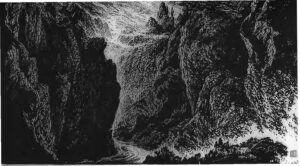
channel and the house to the right.
The Three Gorges Dam Project under construction on the Yangtze River in the People’s Republic of China offers geographers and educators a topic of global significance, a wealth of accessible resources and plentiful opportunities for developing geographic literacy.
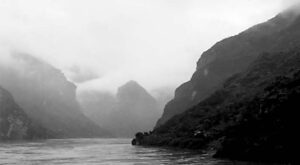
The Three Gorges Dam will be the largest dam in the world, eight times the size of the Aswan Dam.2 The dam will create a reservoir 370 miles in length, displace upwards of 1.3 million people from their cities, villages and farms, submerge forever hundreds of priceless archaeological sites, and cost from 17.5 to 50 billion dollars.3 Why has the Chinese government undertaken this immense infrastructure project? What are the possible benefits? What are the risks?
This article gives an overview of the history, environmental implications, and controversies surrounding this huge public works project, and provides samples of student work, lesson plans, and a comprehensive resource list. Educators should note that lessons include directions for an environmental impact panel, a major map project, a student debate, a time line, poster projects, and activities related to literature about the Yangtze.
YANGTZE, YANGTZE
Chang Jiang—“Long River,” Da Jiang—“Great River,” Jiang—“The River.” The Yangtze, now often romanized as Yangzi, is central to the cultural and historical identity of the Chinese people. The Great River is the third longest in the world, after the Amazon and the Nile. Originating in rugged mountains near the Tibetan border, the Yangtze flows southeast until it reaches Shigu in the province of Yunnan, where the river makes a dramatic hairpin turn to the north as it ricochets off the limestone cliffs of Yun Ling (Cloud Mountain).
One author muses that Cloud Mountain just might be the most important mountain in the world.4 It forms a barrier which forces the swift currents of the Yangtze sharply northward, back towards central China and the Three Gorges area which lies east of Chongqing. If this mountain were not in this precise location, the Great River might continue to wend southward, losing itself in regions south of the Chinese border. Without the Yangtze’s powerful presence coursing through China from west to east, China’s history, culture, and economy might have taken a dramatically different turn.
If the Yangzte River were superimposed on the United States, it would originate in the Rocky Mountains west of Denver, gradually turn southeast to Dallas, then work its way back north to flow into the Atlantic near New York City.5 Its 4,000 mile length divides China into a northern wheat growing region and a southern region dominated by rice cultivation. The Great River features prominently in poetry, folklore, and legends, and unforgettably in the visual arts.
The Yangtze was of strategic importance during World War II, when Chongqing became the inland capital of the Nationalists after the Japanese invaded China in 1937. The Japanese were never able to penetrate and reach Chongqing because the geographic barrier created by the narrow gorges formed a natural defensive line. In a 1995 Foreign Affairs article, Audrey Topping succinctly described the Yangtze’s general impact. “No river has touched so many lives. More than 380 million people, a third of China’s population, live along its banks, where half of China’s food is grown.”6 It is a dragon, it is the heartbeat. And it is vulnerable.
THE NEED FOR CLEAN ENERGY
China desperately needs a clean, renewable source of energy to achieve its goal of nationwide modernization. Since the breakup of the former Soviet Union, China has moved into second place behind the United States in generating carbon dioxide emissions that contribute to global warming.7 With the country depending largely on coal to drive its economic climb, air quality over urban and some regions of rural China is abysmal, with high emissions of sulfur and carbon-based gases and complaints of acid rain from as far away as Korea and Japan. There is limited electrical power in the area of the proposed dam, with frequent brownouts and blackouts.8
Supporters of the dam predict hydroelectric output equal to eighteen nuclear power plants once the dam is operational. The Chinese government claims energy produced by the dam’s huge turbines will provide at least ten percent of the electricity in China, most of which will be used in Sichuan and Hubei Provinces.9
Proponents claim that the dam’s generation of electricity by hydropower will significantly reduce China’s output of dangerous atmospheric pollutants. If the dam is not built or if the emission problem is not addressed in some other way and China continues to use coal for seventy-five percent of its energy needs, the greenhouse effect could be catastrophic.10 With up per respiratory problems identified as the greatest single cause of death in China, any move to reduce airborne pollutants needs to be given serious attention.
ECONOMIC DEVELOPMENT OF THE INTERIOR
As the major waterway in the country, the Yangtze transports seventy-eight percent of China’s river-borne freight.11 However, current navigational difficulties in the Three Gorges region make it impossible for the river to meet the growing transportation demands of the burgeoning economy. Westerners hear of dramatic changes and economic growth rates of eleven percent per year in China, not realizing, perhaps, that such news comes largely from regions near the coast. In contrast, there is less modernization or infrastructure in the remote region where the dam will be located. There are limited markets for goods produced in this area, and road transportation through mountainous regions is difficult and dangerous.
With limited highway connections, it is exceedingly difficult for truckers to get through, making the river of singular economic importance as a pathway for the movement of goods.12 In fact, the only practical long range transport is along the river’s course. Hence the appeal of making a shipping channel that is deep enough and wide enough to enable 10,000-ton ships to reach the port of Chongqing 1,500 miles from the Pacific coast.13 Chongqing will lie at the western end of a reservoir the length of Lake Superior.
Supporters of the project claim it is imperative that the Yangtze be made navigable for larger ships and open to large scale commerce. If the dam is completed successfully as planned, huge tankers, trading ships, and ocean-going tourist vessels will glide inland where once trackers pulled their narrow junks inch by inch against the current. The potential bene fits of this economic superhighway are tantalizing. “. . . The dam would increase capacity for shipping fivefold and decrease shipping costs by about thirty-five percent.”14
FLOOD CONTROL
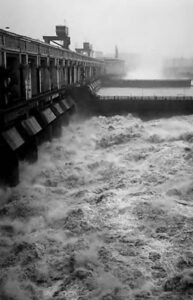
One of the primary purposes of the dam is to control the disastrous flooding which has plagued the population living along the river’s banks. Devastating floods have been documented since the Han dynasty. Some towns are situated lower than the river, protected by dikes which, when breached, permit the river to inundate the surrounding countryside with ferocious speed. There have been over 300,000 lives lost to Yangtze floods in this century. A 1991 flood left thousands dead and millions homeless, damaging close to thirty-five million acres of valuable agricultural land. With about one quarter of the world’s population and a narrow agricultural base (only about seven percent of the land in China is arable), even temporary loss of arable acreage is significant. Repairs in the wake of such floods add to their cost. Supporters of the dam promise flood control and as a fringe benefit, increased water for irrigation.
HISTORY
It is interesting that the idea for a colossal dam on the Yangtze has been under consideration since the early years of the Chinese republic. Sun Yat-sen first proposed a similar dam project in 1919 as part of a pro gram to industrialize China. American engineers conducted surveys during the 1920s, doing preliminary feasibility studies.15 During the 1950s some of the worst rapids were blasted away. Chairman Mao himself wrote a poem in 1956 which makes direct reference to the dam in the following excerpt:
Walls of stone will stand upstream to the west
To hold back Wushan’s clouds and rain
Till a smooth lake rises in the narrow gorges. . . .16
In 1958, Mao formally proposed the massive dam, but political strife related to the Great Leap Forward made planning and construction impossible. Construction on a less ambitious project, the Gezhouba Dam, was started in the 1970s as a trial run, or pilot, for the Three Gorges project. The Gezhouba dam lies about fifteen miles east of the new dam site. It is a low dam, 150 feet in height, causing minimal change in the water level. Though not large enough to provide flood protection, it has been very successful at producing hydroelectric power. In fact, profits from the Gezhouba Hydroelectric Power Station will help fund construction on the Three Gorges Dam.
Deng Xiaoping continued to support the project in the 1980s, and Chinese Premier Li Peng, a hydrologist, has been pushing the project for years. During the relative stability of the 1980s, the Yangtze River Planning Commission began feasibility studies to consider how large a dam would be necessary to fulfill the governmental objectives of energy production, economic development, and flood control.
POLITICAL CONTROVERSY
During the same decade, opponents of the dam became more outspoken. Critics of the big dam still contend that a series of small dams on the Yangtze and its tributaries would be more environmentally sound and less expensive than one large dam. They decry the reckless exploitation of nature which characterizes the Chinese government’s attitude towards development. They are outraged at plans to set up huge illuminated billboards in Xiling Gorge “. . . to advertise China’s growing alcoholic beverage industry. . . .”17
In the spring of 1989, Dai Qing, an author and investigative journalist with a degree in engineering and a lot of courage, published Yangtze! Yangtze! This collection of articles expressed the views of forty scientists, economists and journalists with deep concerns about the Three Gorges project. In July 1989, after the Tiananmen Square incident, Dai Qing was arrested and spent ten months in prison, six of these months in solitary confinement. Dai Qing asserts the true reason for her arrest was her writing on the dam project.18
Chinese scientists, engineers, and politicians opposed to the project claim they have been silenced and systematically excluded from the planning process from the start. They claim that the officials who staff the planning office “. . . stand to profit monetarily and to cement their power base by building the biggest dam project ever.”19 Also, in an angry look backward, they expose the twenty-year news blackout which covered up the disastrous collapse in 1975 of two “iron dams” which the Chinese government had declared indestructible.20 Critics point to cover-ups of unfavorable data relating to Three Gorges planning and construction as well.
To centralize political control over the dam region, the National People’s Congress has removed Chongqing and surrounding territory from Sichuan Province and created a new municipality which will be directly accountable to Beijing. The newly formed municipality is nearly the size of Austria and has 30.2 million people living within its boundaries.21 This change in administrative status will streamline the decision making process, a desirable out come for dam proponents.
Clearly a volatile political standoff with high stakes has developed, but the controversy is not officially acknowledged by the Chinese government, and the playing field is not level. In 1992, the communist leaders “rammed” the project through the National People’s Congress,22 and Li Peng proudly presided over the first pouring of concrete for the dam in December, 1994. With the diversion of the Yangtze channel in early November of 1997, the government attained the “. . . ‘double happiness’ of damming the river and recovering Hong Kong in the same year.”23
Some 50,000 spectators joined President Jiang Zemin and Premier Li Peng on November 8, 1997 to witness the blocking of the Yangtze with a cofferdam. Some 400 trucks dumped large boulders and earth in order to close the narrow gap and turn the flow of the river into a diversion channel that had been dug over the previous two years. With this work done, the difficult second phase that will lead to the raising of the water level and power generation begins.
Need for clean energy? Undeniable. Need for economic development? Absolutely clear. Flood Danger? A continuing threat, especially with in creased global warming and deforestation upstream. Risk factor of the project? High. Environmental Impact? Literally incalculable.
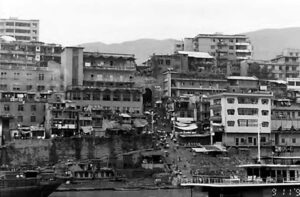
ENVIRONMENTAL AND HUMAN ATROCITY? THE “DOWNSIDE”
“From the bottom of my heart, I don’t want to move, but I have no way to stay. . . .” 24
The economic promise of the dam whispers incessantly, but the environmental and human costs are incalculable. Even Lu Youmei, head of the Three Gorges Project Development Corporation, admits to three “big difficulties” facing the project: a shortage of funds, ecological damage, and forced resettlement.25
MEGA PROJECT FOR MEGA BUCKS
Structural and technological demands of the dam are unprecedented in their size and scope. The dam will be built inside Xiling, the first of the Three Gorges. It will be 1.3 miles across and will have twenty-six turbines and five locks, each sixty-five feet high. The dam and huge reservoir will irreparably alter the magnificent landscape of the Three Gorges region. Chongqing will be the western terminus and is projected to become the largest in land port in the world. The city is already experiencing a building boom. Old neighborhoods with narrow winding streets and pagoda roofs have been replaced by rectangular apartment blocks with colorful awnings placed well above the new water line. The project has its supporters. According to Cheng Daan, a construction official, “The building of the Three Gorges will reinvigorate the whole of China. After completion of the Three Gorges, the Yangtze will be come a golden waterway.”26
This mother of all dams will take seventeen years to build, and it will be costly! Without significant outside investment, the project is beyond the reach of the Chinese government. After scrutinizing detailed feasibility study, the World Bank has refused to fund it. The U.S. Import/Export Bank has turned down financial guarantees to U.S. corporations hungering for a piece of the action. Dozens of firms from many countries—Caterpillar, General Electric, Mitsubishi, Toshiba—are bidding on contracts worth billions of dollars as they compete to build various components of the dam.27 Almost all the hydropower equipment will be foreign made, including all twenty-six of the turbines. One sure indica tion that the price tag will be higher than anticipated is that certain costs have not yet been factored in. “Not yet estimated . . . are the costs of re building the Nanjing and Wuhan bridges that were built in the 1950s for passage of 5,000-ton ships. . . ,”28 not for the 10,000 foot tankers of the future.
Perhaps the only thing that could stop the dam is a total breakdown in financing. The dam was approved in the early 1990s in the context of a booming economy. In the current context of economic crisis in Asia, investors are left wondering if China will be next. Coupled with South Korea’s and Indonesia’s difficulties, the fact that Malaysia has cancelled, or “postponed” its largest infrastructure project, the Bakun Dam, is surely sending shivers down some spines.
ENVIRONMENTAL ATROCITY?
The vast reservoir may have an impact on the climate and temperature of the region, and hence on the flora and fauna. Tangerines, a major cash crop which is altitude specific, may not survive a move to higher ground.29 Mulberry tree plantations which nurture the valuable silk worm will be submerged. A delicate maidenhair fern, used for medicinal purposes, is also endangered. There are therefore huge agricultural questions, with effects on plant life unknown.
Animals will be heavily impacted. Species such as the Chinese alligator, the cloud leopard, and the Yangtze River sturgeon most probably would not survive.30 The river also provides habitat for
the Siberian white crane, which might be eliminated from the area. Most endangered is the unique Chinese river dolphin, of which less than 300 remain. This unique species is “. . . already threatened by ships’ propellers, long fishing lines, and explosives used for illegal fishing.”31
Silting and pollution provide dire threats. Sedimentation build-up above the dam is a given. The Yangtze already carries over 680 million tons of soil, silt and sand to the sea, over 1,000 times the amount carried by the Mississippi.32 Costly removal of sedimentation is highly likely, but the success of this procedure is uncertain.33 Increased deforestation once the resettled farmers move further up the river’s banks to clear land for their new farms exemplifies a hidden environmental cost. If such deforestation leads to increased erosion and the unexpectedly rapid build-up of sedimentation in the new reservoir, the cost of sediment control will escalate even further.
The relatively still waters of the reservoir may create a pollution problem of immense proportions. Industrial and human waste, plastic, petrochemicals, even discarded furniture, which have flowed out to Shanghai and the East China Sea, will accumulate with the decrease in water flow. Since the river is the source of drinking water for the cities along its banks, sanitation and health conditions might worsen. No funds have been set aside for water treatment.34 A less obvious but insidious threat could develop with the increased amount of standing water. A small snail which produces a parasitic flatworm called schistosomiasis flourishes in still waters and already infects residents in the area with tissue damage and loss of blood. It may pose a more serious health threat once the flow of the Yangtze is slowed in the reservoir region.
The loss of historical and cultural sites can be seen on the accompanying map. With the water level scheduled to rise between the years 2003 and 2009, there is very little time to study the many sites, and the limited budget will not begin to cover comprehensive research.
Opponents assert the dam would be vulnerable to sabotage. Engineers disagree about what would happen with a major earthquake, or if the dam becomes a military target, but clearly the results could be devastating. Some seismologists claim that the reservoir “. . . will be over an active fault line and the weight of the water could trigger an earthquake that could demolish the dam. . . ,” leading to disaster for cities downriver.35
RESETTLEMENT

The most wrenching issue is the forced relocation of 1.3 million people, about eighty percent of whom live in the countryside. In raising the water level 574 feet between the cities of Wuhan and Chongqing, creating the largest reservoir in the world, the project will submerge 13 cities, 140 towns, 955 business enterprises, 1,352 villages, and 115,000 acres of prime agricultural land.36 Dachang, a town built during the Ming dynasty, will disappear completely.37 In the larger cities, local governments are al ready constructing replacement buildings on high ground, and there is fierce competition for the new units.
The plight of city dwellers displaced by the project is actually less traumatic than the situation facing people in the countryside. Zhang Yonglin, a prosperous farmer, is among those who will be resettled. “It’s a pity so much fertile land must be lost. . . . My family has been here since the Ming dynasty. . . . I don’t know when we’ll have to move. Or even where we’ll be moved. You have to take what the state gives you. There is no bargaining.”38
Most rural farmers, already poor, will be moved back and up the banks of the river where there are no roads or terraces. In one town, residents will be moved to inferior land where the annual per capita in come is significantly lower. Many will be moved to crowded areas where they are not welcome.39 The government fears a backlash from those who will be forcibly resettled, but the resettlement process continues, implemented by local officials with limited funds.
For the leaders of China, the dam, as the world’s biggest engineering project, symbolizes power and accomplishment, a crown for the heads of the new emperors. For the entrepreneur, financial opportunity beckons. For the farmers, who comprise half the people slated to be moved, the personal and financial losses are agonizing and irreplaceable. For the environment, haunting questions remain.
THE THREE GORGES LESSON PLANS
INTRODUCTION TO LESSON PLANS
The topic brims with opportunities for research and analysis. The following lessons could be integrated into such courses as World History, Asian History and Culture, World or Regional Geography, Twentieth-Century History, International Relations, Environmental Science, Economics. Educators familiar with the National Geography Standards will find connections to almost
every standard. Sources are plentiful, as can be seen from the lengthy resource list.
THE LESSON PLANS
1. Debate Project 4. Time Line
2. Environmental Impact Panel 5. Poster Project
3. Big Map 6. Literature
DEBATE!
THE PROPOSITION: “Construction on the Three Gorges Dam project should be stopped immediately.”
Since 1993, high school students in my World History course at Newton Country Day School have participated annually in a spirited debate on the pros and cons of the Three Gorges Project. The Dam Project has stimulated serious research resulting in deepened understanding of energy needs, environmental impact, the complex role of politics, and urban/rural and coastal/inland distinctions within the People’s Republic. Students are required to write a carefully researched position paper and prepare rebuttals in advance of the structured oral debate.
The Debate Project is recommended for high school through college level students. Allow one week for research, planning and oral debate; allow two weeks if a position paper is required.
ENVIRONMENTAL IMPACT PANEL
This project involves research and the preparation of position papers. It culminates in a panel presentation in which participants deliver their speeches as they role play certain identities, outlined below. This is a less threatening format than the debate and allows for more focused research by participants, since they will be looking into one or another perspective. This activity is appropriate
for middle school through college level. Allow one to two weeks for research and writing, depending on accessibility of resources and depth desired.
Special thanks to Deirdre Chetham, Executive Director of the Fairbank Center for East Asian Research at Harvard University, for her assistance in preparing these identities.
IDENTITIES
Central Government Official. This official would be a strong supporter of the views of Li Peng, second primary leader of China and a hydrologist who strongly favors the building of the dam. He/she would be working closely with the Three Gorges Project Development Corp., which is in charge of building the dam.
Local Government Official. This local official, possibly a mayor, has the responsibility for implementing the orders of the central government to resettle urban and rural inhabitants of regions that will be submerged. He/she is caught between orders from above, and loyalty and affection for people in his district, and his budget is limited.
Archaeologist/Historian. Deeply concerned about the losses of historic sites, the archaeological team has been frustrated by lack of funds and the rapidly approaching deadline when the waters will begin to rise.
Local Farmer to be Resettled. As a prosperous farmer whose family has tilled this land since the Ming dynasty, Mr. Li does not know when or where he will have to move. He is concerned that he will receive inferior land and decreased income. His wife and three school-age children are also concerned.
Environmentalist. Dr. Lam works at a university in the Department of Environmental Science. He is deeply concerned about the impact of the dam on various ecosystems, and fears human meddling with the grandiose force of the Yangtze River.
Local Middle School Teacher. Ms. Wang is a dedicated teacher employed by her city’s government. Though she is nostalgic about leaving her home, she is eagerly anticipating a move to the top of the river’s bank where she, her husband, and child will receive improved housing, with electricity and indoor plumbing.
THE BIG MAP PROJECT
Appreciation for the geographic complexities of the Yangtze River region will be enhanced by the “Big Map” Project. Hands-on geography forms the basis for critical thinking about geographic relationships. If done in detail, the map could be used as visual backdrop for a debate or an environmental impact presentation, or it could stand on its own.
In making the map, it is key to use only a simple outline map for students to project and draw, for they have the fun and stimulation of deciding which elements to include to enhance their own Big Map.
This activity is appropriate for learners in upper elementary grades through high school. Tracing the whole outline with physical features should take no more than twenty to thirty minutes. Students can then roll the map up to take home for further work.
OBJECTIVES
Students will:
1. develop their own large map
2. portray relevant geographic information on this map
3. see relationships between human and natural environments
4. gain appreciation of planning and cooperative learning
5. apply critical thinking skills
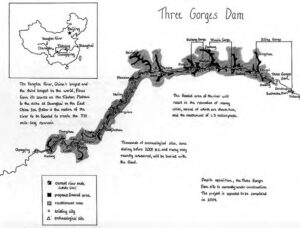
MATERIALS
1. overhead projector
2. transparency with a simple outline map of China and its rivers
3. pencil and permanent, thick markers
4. a large piece of butcher paper* taped to a smooth part of the wall.
A good size is 3’ by 4’. The larger the map, the more engaging it is for students.
*or four pieces of chart paper taped together on the back
1. PROCEDURES FOR DRAFTING A BIG MAP
A. PREPARE A TRANSPARENCY FOR THE OVERHEAD PROJECTOR
- Choose an outline map of any size which shows natural features, including the Yangtze River, and political boundaries if you wish. There should be no writing on the map, as the students will locate and name places themselves.40
- If you cannot find an outline map, trace one from an atlas.
- Make an overhead transparency from your outline map.
B. BEFORE STUDENTS ARRIVE IN CLASS
- Tape a large piece of butcher paper as smoothly as possible onto a smooth wall (wrinkles will result in inaccuracies right from the beginning). Alternatively, use a large flat piece of cardboard or foam-core board suspended vertically against a hard surface.
- Using the overhead projector, focus the transparency on the butcher paper, adjusting the projector until the map fills the entire space. Tape the transparency to the surface of the projector and tape the projector stand to the floor. It is essential not to move this arrangement once the students begin to trace the image onto the butcher paper because it is very hard to reposition the image on the wall.
C. STUDENTS TRACE THE BIG MAP ONTO PAPER OR BOARD USING PERMANENT MARKERS
- While class completes an assignment using 8 1/2” by 11”
copies of the map, call two students at a time to begin tracing
the outline map in pencil.
2. DEVELOPING THE MAP
Students can embellish a physical map with information relating to the Three Gorges Dam Project. Individuals can add graphs, drawings, and even poems and quotations to the periphery of the map. Special thanks to Anne S. Watt of The New England China Network for providing instructions for the Big Map Project.
TIME LINE
There are sufficient resources for students to create a comprehensive time line of events related to the planning, construction, and controversies surrounding the Three Gorges Project. Student groups could work collaboratively to create parallel time lines relating to political, economic, environmental, and social factors. Some students might wish to develop an enlarged, illustrated time line, and some may want to incorporate material from the Madeleine Lynn book, which offers accounts of the Yangtze through the centuries. (See resource list.) The Chinese embassy also provides
a comprehensive chronology at their website: http://www.china-embassy.org.
POSTER PROJECT
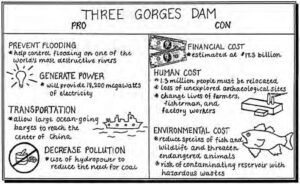
A sample of a student Pro-Con poster appears as part of this article. There are many possibilities for posters, ranging from explanatory visual posters relating to the construction, to posters dealing with environmental impact, resettlement, political opposition, economic benefits. Charts detailing important statistics would aid understanding.
LITERATURE
The Yangtze River: The Wildest, Wickedest River on Earth, edited by Madeleine Lynn and recently published, provides students of literature with over fifty entries. Mao’s poem “Swimming” could be a stimulus for research on the history of the dam or could lead students to explore other poetry written about the Yangtze. John Hersey’s short work, A Single Pebble, recounts the experience of an American engineer assigned to explore the feasibility of damming the Yangtze in the 1920s. Students could trace his changing perceptions of Chinese culture as he moves further and further up the Yangtze.
1. Simon Winchester, The River at the Center of the World: A Journey Up the Yangtze and Back in Chinese Time (New York: Henry Holt and Company, 1996), 218.
2. Lecture by Deirdre Chetham, Executive Director, Fairbank Center for East Asian Research, Harvard University. Modern China in Transition Institute, The New England China Network, July 21, 1997.
3. Audrey R. Topping, “Ecological Roulette: Damming the Yangtze,” Foreign Affairs (September- October, 1995), 144. Topping gives the cost of the dam as between 17.5 and 30 billion dollars. Ann Zwinger predicts a higher pricetag, “. . . an incredible cost of at least $40 billion, a figure that has been rising steadily with almost every report.” Ann Zwinger, “Last Look at the Long River,” Audubon (May-June, 1997), 81.
4. Winchester, 4.
5. Ann Zwinger, “Last Look at the Long River,” Audubon (May-June, 1997), 78.
6. Topping, 136.
7. Arthur Fisher, “World’s Largest Dam,” Popular Science (August, 1966), 70.
8. Chetham Lecture.
9. Deirdre Chetham, Interview, Fairbank Center for East Asian Research, Harvard University, September 19, 1997.
10. Fisher, 70.
11. Topping, 145.
12. Chetham Lecture.
13. Fisher, 69.
14. Topping, 145.
15. John Hersey, A Single Pebble (New York: Vintage Books, 1984). In this short, informative historical novel, the narrator/engineer describes his upriver journey on a traditional river junk as he experiences cultural differences and contemplates the possibility of erecting a dam in the gorges.
16. Madeleine Lynn, Editor, Yangtze River: The Wildest, Wickedest River in the World (Hong Kong: Oxford University Press, 1997), 121.
17. Lawrence Sullivan, “The Three Gorges Project: Dammed if They Do?” Current History (September, 1995), 266.
18. Paul Mooney, “Dam Buster: The Three Gorges Project Stirs a Writer into Action,” Far Eastern Economic Review (November 20, 1997), 82.
19. Dai Qing, The River Dragon Has Come! The Three Gorges Dam and the Fate of China’s Yangtze River and Its People (New York and London: M.E. Sharpe, Probe International and International Rivers Network, 1997), xviii.
20. Dai Qing, xv and 25 ff. The authors devote the third essay in this book to “The World’s Most Catastrophic Dam Failures: The August 1975 Collapse of the Banqiao and Shimantan Dams”
in which 85,000 victims lost their lives.
21. Arthur Zich, “China’s Three Gorges Before the Flood,” National Geographic (September, 1997) 18–19.
22. Sandra Burton, “Taming the River Wild,” Time (December 19, 1994), 62.
23. Sullivan, 267.
24. Sheila Tefft, “Despite Controversy, China Pushes Ahead on Colossal Dam,” The Christian Science Monitor (May 11, 1994), 11. Comment by Zhang Jianhua, one of more than 1 million
Chinese forced to move by the dam project.
25. Sullivan, 266.
26. Tefft, 12.
27. Dai Qing, xviii.
28. Dai Qing, xviii.
29. Chetham lecture.
30. Sullivan, 267.
31. Fisher, 70.
32. Zwinger, 81.
33. Luna B. Leopold, Emeritus Professor of Geology, University of California, Berkeley, comments on the issue of sedimentation, warning of ongoing erosion downstream. “. . . the dam’s claimed function of storing floods conflicts with the need to flush through the sediment-filled floodwaters. . . . (and) the sediment-deprived waters discharged by the dam would be highly erosive, thus undermining flood control levees downstream.” “Eminent U.S. Dam Expert Criticizes Three Gorges,” International Rivers Network, //www.irn.org/programs/3g/prleopold 960422.html).
34. Fisher, 70.
35. Topping, 139.
36. Zwinger, 78, and Topping, 140. Catherine Caulfield, in her article, “Rough Sailing at Three Gorges Dam,” World Rivers Review (December, 1997), sets the amount of farmland to be lost at 620,000 acres.
37. Zwinger, 78. Zwinger laments the loss of Dachang “. . . an acknowledged center of herbal medicine . . . the town retains the best examples of Ming Dynasty homes and narrow streets. . . . A treasured landmark, the red, multistoried Shibaozhai Pagoda, will disappear. . . .Resettlement figures from previous Chinese dams are not cheering; of the 10 million people who lost land to other projects, at least a third do not now have living conditions as good as those they were forced to leave. It makes one cynical to contemplate the $534 million ‘promised’ for relocation efforts that some economists estimate could cost as much as $1 billion.” 81.
38. Zich, 17. Past copies of National Geographic can be purchased for $5.00 from the National Geographic Society, P.O. Box 98199, Washington, D.C. 20090-8199. Call toll free at 1-800- 647-5463 for information. This issue, with its striking photographs, detailed map, and informative text, is a bargain.
39. Chetham lecture.
40. Outline Maps on File, published by Facts on File, Inc. (1997), contains an excellent map of China, ideal for this purpose.

